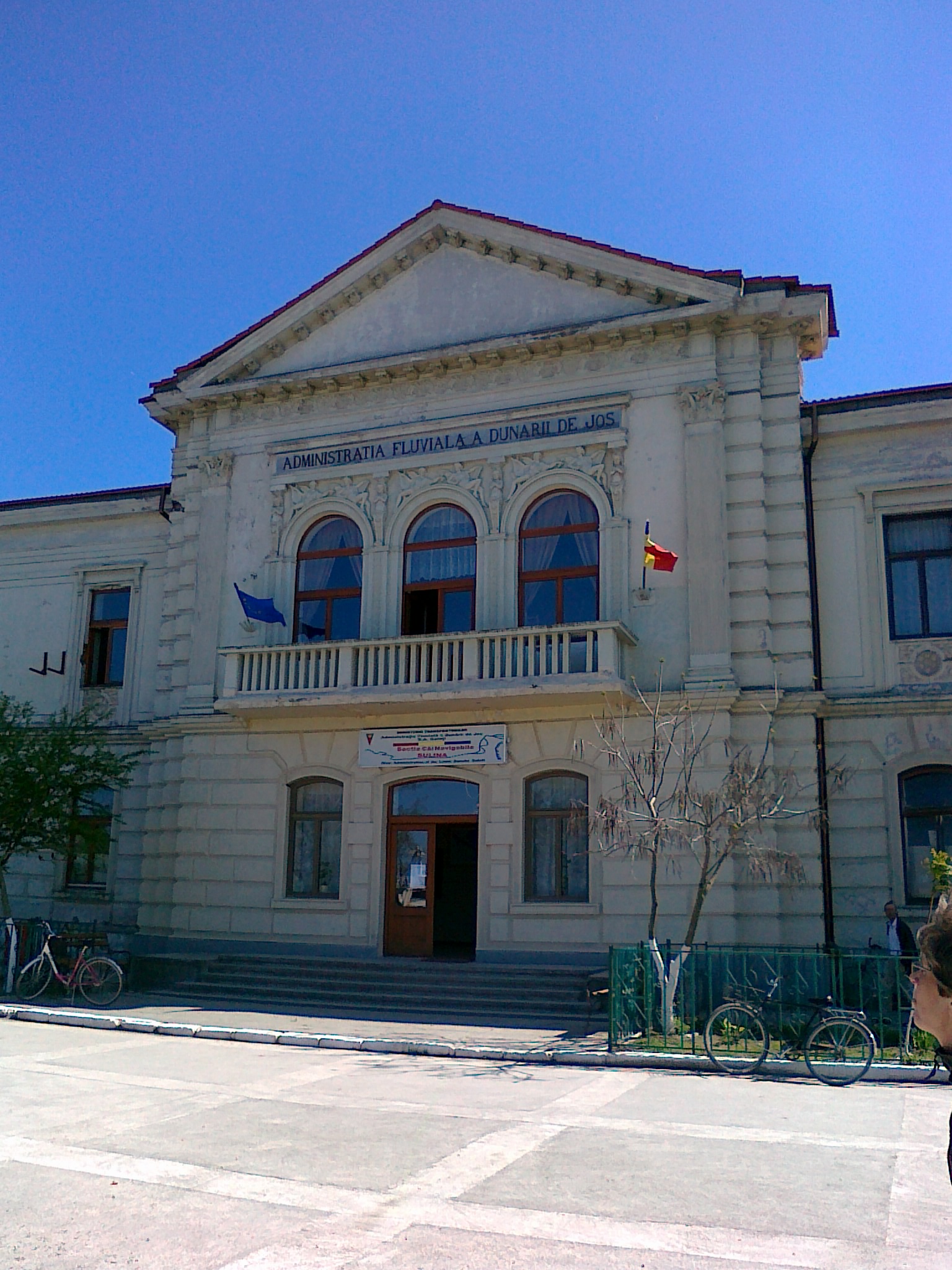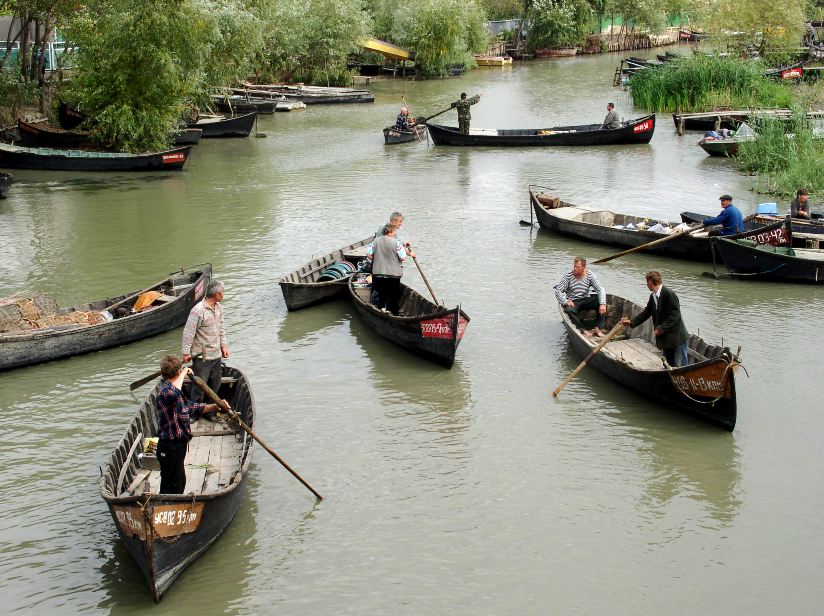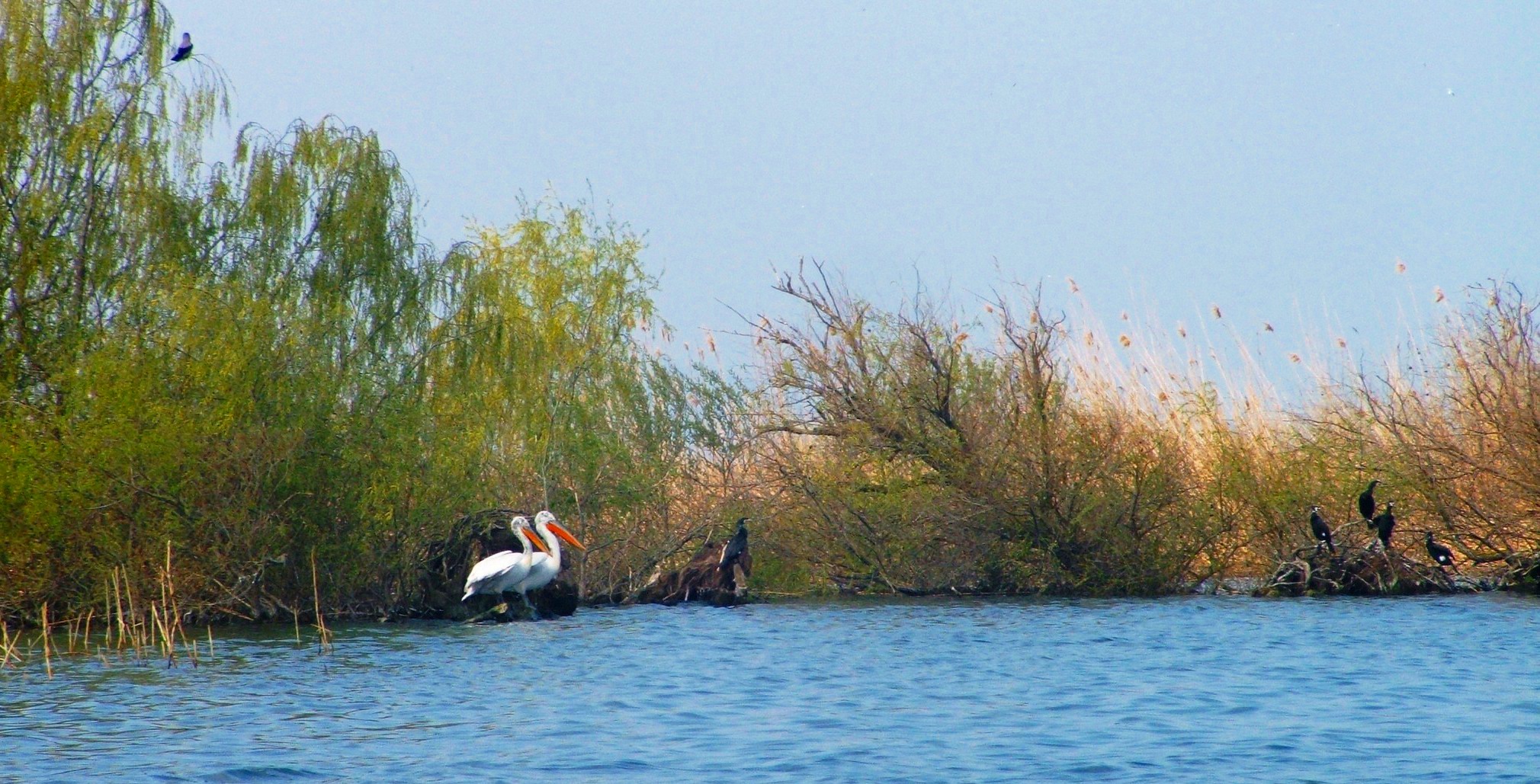|
Tulcea County
Tulcea County () is a county (județ) of Romania, in the historical region Dobruja, with the capital city at Tulcea. It includes in its northeast corner the large and thinly-populated estuary of the Danube. Demographics In 2011, Tulcea County had a population of 201,462. The population density was 23.7/km², the lowest among the counties of Romania, due to the inclusion within the area of the lowly-populated Danube estuarial wetlands. * Romanians - 89.13% * Lipovans - 5.41% * Turks - 0.93% * Romani - 1.87% * Greeks - 0.65% In the Danube Delta there is an important community of Russians and Lipovans. In the south of the county there are communities of Turks. The region once was a centre of Islam in Romania. Geography The county has a total area of . The most significant feature of Tulcea County is the Danube Delta, which occupies about 1/3 of the entire surface and is located in the North-East side of the county. The Delta has three main branches: the Sulina ... [...More Info...] [...Related Items...] OR: [Wikipedia] [Google] [Baidu] |
Counties Of Romania
, alt_name = , alt_name1 = , alt_name2 = , alt_name3 = , alt_name4 = , map = , category = Unitary state , territory = Romania , upper_unit = , start_date = 1995 (Current form, 41 + Bucharest) , start_date1 = 1859 (33) , start_date2 = 1926 (71) , start_date3 = 1941 (73) , start_date4 = 1968 (38 + Bucharest + Ilfov Agricultural Sector) , start_date5 = 1981 (40 + Bucharest) , legislation_begin = , legislation_begin1 = , legislation_begin2 = , legislation_begin3 = , legislation_begin4 = , legislation_end = , legislation_end1 = , legislation_end2 = , legislation_end3 = , legislation_end4 = , end_date =1950–1968 , end_date1 = , end_date2 = , end_date3 = , end_date4 = , current_number = 41 , number_date = 1995 , type ... [...More Info...] [...Related Items...] OR: [Wikipedia] [Google] [Baidu] |
Lipovans
, flag = Flag of the Lipovans.png , flag_caption = Flag of the Lipovans , image = Evstafiev-lipovane-slava-cherkeza.jpg , caption = Lipovans during a ceremony in front of the Lipovan church in the Romanian village of Slava Cercheză in 2004 , population = , region1 = , pop1 = 23,487 , ref1 = , region2 = , pop2 = , ref2 = , region3 = , pop3 = , ref3 = , region4 = , pop4 = 700–800 , ref4 = , religions = Old Believers (Eastern Orthodox Christianity) , languages = Russian, Romanian, Ukrainian, Bulgarian , related = Russians , footnotes = The Lipovans or Lippovans (russian: Липовáне; ro, Lipoveni; uk, Липовани; bg, Липованци) are ethnic Russian Old Believers living in Romania, Ukraine, Moldova and Bulgaria who settled in the Principality of Moldavia, in the east of the Principality of Wallachia (Muntenia), and in the regions of Dobruja and Budjak during the 17th and 18th centuries. According to the 2011 Romanian ... [...More Info...] [...Related Items...] OR: [Wikipedia] [Google] [Baidu] |
Chilia Branch
The Chilia branch (; ) is one of three main distributary channels of the river Danube that contributes to forming the Danube Delta. Lying at the northernmost area of the delta, the distributary creates a natural border between Romania and Ukraine (see Romania-Ukraine border) and is named after the two towns carrying the same name, located across from one another on both banks: Kiliya, on the northern, Ukrainian bank and Chilia Veche (Old Chilia) on the southern, Romanian bank. The other two main branches of the Danube are the Sulina branch and the Sfântu Gheorghe branch. The Chilia branch begins at the Ismail Islet where Danube splits on Chilia branch and Sulina branch and ends near the town of Vylkove where Chilia branch splits further into Ochakove distributary (eastward) and Old Istambul distributary (southward). Chilia branch is long. The flow at the entrance into the delta is of 6,350 m3/s; the Chilia branch carries between 58 and 60 percent of this flow ... [...More Info...] [...Related Items...] OR: [Wikipedia] [Google] [Baidu] |
Sulina Branch
The Sulina branch is a distributary of the river Danube, that contributes in forming the Danube Delta. The other two main branches of the Danube are the Chilia branch The Chilia branch (; ) is one of three main distributary channels of the river Danube that contributes to forming the Danube Delta. Lying at the northernmost area of the delta, the distributary creates a natural border between Romania and Ukra ... to the north and the Sfântu Gheorghe branch to the south. The Sulina branch runs straight east, starting at Tulcea and reaching the Black Sea at the port of Sulina. Distributaries of the Danube {{Tulcea-geo-stub ... [...More Info...] [...Related Items...] OR: [Wikipedia] [Google] [Baidu] |
The Palace 02
''The'' () is a grammatical article in English, denoting persons or things that are already or about to be mentioned, under discussion, implied or otherwise presumed familiar to listeners, readers, or speakers. It is the definite article in English. ''The'' is the most frequently used word in the English language; studies and analyses of texts have found it to account for seven percent of all printed English-language words. It is derived from gendered articles in Old English which combined in Middle English and now has a single form used with nouns of any gender. The word can be used with both singular and plural nouns, and with a noun that starts with any letter. This is different from many other languages, which have different forms of the definite article for different genders or numbers. Pronunciation In most dialects, "the" is pronounced as (with the voiced dental fricative followed by a schwa) when followed by a consonant sound, and as (homophone of the archaic pr ... [...More Info...] [...Related Items...] OR: [Wikipedia] [Google] [Baidu] |
National Institute Of Statistics (Romania)
The National Institute of Statistics ( ro, Institutul Național de Statistică, INS) is a Romanian government agency which is responsible for collecting national statistics, in fields such as geography, the economy, demographics and society. The institute is also responsible for conducting Romania's census every ten years, with the latest census being organised in 2011. Leadership The head of the NIS is currently Tudorel Andrei, while the three vice-presidents are: *Elena Mihaela Iagăr, in charge of economic and social statistics *Marian Chivu, in charge of national accounts and the dissemination of statistical information *Beatrix Gered, in charge of IT activities and statistical infrastructure History Romania's first official statistics body was the Central Office for Administrative Statistics (''Oficiului Central de Statistică Administrativă''), established on July 12, 1859, under the reign of Alexandru Ioan Cuza. The organisation, one of the first national statistics org ... [...More Info...] [...Related Items...] OR: [Wikipedia] [Google] [Baidu] |
2022 Romanian Census
The 2022 Romanian census was a census in Romania that began on 1 February 2022. It was supposed to be done in 2021, but it was postponed due to the COVID-19 pandemic in Romania in order to avoid census takers from getting infected when coming into contact with ill or quarantined people. It was the first census held in Romania in which data was collected online, something that had support among Romanian youth. The census was divided into three phases: one in which personal data of the Romanian population was collected from various sites; another in which the population was to complete more precise data such as religion, in which town halls would help the natives of rural areas to answer the census; and a third one in which census takers would go to the homes and households of those who did not register their data online. Data for this census was planned not to be collected on paper, but instead with tablets so as to maintain social distancing between citizens. The entire data coll ... [...More Info...] [...Related Items...] OR: [Wikipedia] [Google] [Baidu] |
Islam In Romania
Islam in Romania is followed by only 0.3 percent of population, but has 700 years of tradition in Northern Dobruja, a region on the Black Sea coast which was part of the Ottoman Empire for almost five centuries (ca. 1420-1878). In present-day Romania, most adherents to Islam belong to the Tatar and Turkish ethnic communities and follow the Sunni doctrine. The Islamic religion is one of the 18 rites awarded state recognition. According to tradition, Islam was first established locally around Sufi leader Sari Saltik during the Byzantine epoch. The Islamic presence in Northern Dobruja was expanded by Ottoman overseeing and successive immigration, but has been in steady decline since the late 19th century. In Wallachia and Moldavia, the two Danubian Principalities, the era of Ottoman suzerainty was not accompanied by a growth in the number of Muslims, whose presence there was always marginal. Also linked to the Ottoman Empire, groups of Islamic colonists in other parts of presen ... [...More Info...] [...Related Items...] OR: [Wikipedia] [Google] [Baidu] |
Lipovan
, flag = Flag of the Lipovans.png , flag_caption = Flag of the Lipovans , image = Evstafiev-lipovane-slava-cherkeza.jpg , caption = Lipovans during a ceremony in front of the Lipovan church in the Romanian village of Slava Cercheză in 2004 , population = , region1 = , pop1 = 23,487 , ref1 = , region2 = , pop2 = , ref2 = , region3 = , pop3 = , ref3 = , region4 = , pop4 = 700–800 , ref4 = , religions = Old Believers (Eastern Orthodox Christianity) , languages = Russian, Romanian, Ukrainian, Bulgarian , related = Russians , footnotes = The Lipovans or Lippovans (russian: Липовáне; ro, Lipoveni; uk, Липовани; bg, Липованци) are ethnic Russian Old Believers living in Romania, Ukraine, Moldova and Bulgaria who settled in the Principality of Moldavia, in the east of the Principality of Wallachia (Muntenia), and in the regions of Dobruja and Budjak during the 17th and 18th centuries. According to the 2011 Romanian census, ... [...More Info...] [...Related Items...] OR: [Wikipedia] [Google] [Baidu] |
Russians
, native_name_lang = ru , image = , caption = , population = , popplace = 118 million Russians in the Russian Federation (2002 ''Winkler Prins'' estimate) , region1 = , pop1 = approx. 7,500,000 (including Russian Jews and History of Germans in Russia, Ukraine and the Soviet Union, Russian Germans) , ref1 = , region2 = , pop2 = 7,170,000 (2018) ''including Crimea'' , ref2 = , region3 = , pop3 = 3,512,925 (2020) , ref3 = , region4 = , pop4 = 3,072,756 (2009)(including Russian Jews and Russian Germans) , ref4 = , region5 = , pop5 = 1,800,000 (2010)(Russian ancestry and Russian Germans and Jews) , ref5 = 35,000 (2018)(born in Russia) , region6 = , pop6 = 938,500 (2011)(including Russian Jews) , ref6 = , region7 ... [...More Info...] [...Related Items...] OR: [Wikipedia] [Google] [Baidu] |
Danube Delta
The Danube Delta ( ro, Delta Dunării, ; uk, Дельта Дунаю, Deľta Dunaju, ) is the second largest river delta in Europe, after the Volga Delta, and is the best preserved on the continent. The greater part of the Danube Delta lies in Romania ( Tulcea County), with a small part in Ukraine ( Odessa Oblast). Its approximate surface area is , of which is in Romania. With the lagoons of Razim–Sinoe ( with water surface), located south of the main delta, the total area of the Danube Delta is . The Razim–Sinoe lagoon complex is geologically and ecologically related to the delta proper; the combined territory is listed as a World Heritage Site. Geography and geology The modern Danube Delta began to form after 4000 BCE in a bay of the Black Sea when the sea rose to its present level. A sandy barrier blocked the Danube bay where the river initially built its delta. Upon filling the bay with sediment, the delta advanced outside this barrier-blocked estuary after 3 ... [...More Info...] [...Related Items...] OR: [Wikipedia] [Google] [Baidu] |



.png)

.png)
